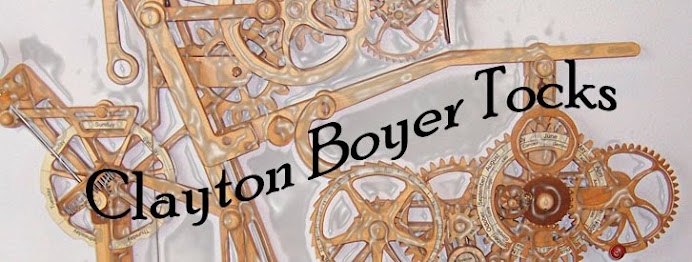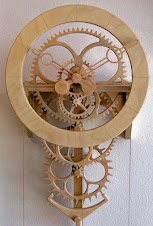Some of my designs use phenolic tube for making a simple and
easy to align bearing pack allowing for very free moving arbors and
pendulums.
Phenolic tube is easily available and inexpensive in the
U.S., but I have recently found that this may not be the case for some other
countries.
The following suggestion came from fellow builder Adrian
Iredale in Australia – a country with apparently a copious phenolic scarcity.
If your country also is suffering from a dearth of phenolic
tubes, or even if you live in a phenolic abundant country and would just
like to try your hand at building a wooden bearing pack, here are the instructions and
pictures on;
How to Make a
Wooden Bearing Pack
to fit 3/8”OD,
3/16”ID, 1/8thickness bearings. Metric
equivalents may be substituted.
I didn't take a picture of this, but the first step is to
cut the 1/2” (12mm) dowel to the correct length as described in the plans and
then chuck the dowel into a hand drill. Get the
drill spinning and mark the center with a pencil - or find some other way to
find the exact center of the dowel.
1)
This picture shows the Jig holding the
dowel. To make this Jig, using your
drill press, drill a perfectly vertical hole in a large block of wood to hold a
1/2” (12mm) wood dowel. Then insert a 1/2” dowel of the correct length for your
bearing pack into the vertical Jig and center drill the dowel with a 3/8”
(10mm) brad point drill bit 1/8” (3mm) deep.
2)
Flip the 1/2” dowel over 180* and drill the
other end the same way.
3)
Then center drill through from both ends with a
1/4” (6mm) metal twist drill. The metal twist
drill will center itself better in the center depression that was left by the original 3/8" brad point. Note that drilling the dowel from both
ends halfway through will better center the 1/4” hole than drilling all the
way through from only one side.
4)
Your wooden bearing pack is now ready to load in
the bearings.
5)
Bearings are pressed into place at both ends.
6)
The 3/16” (5mm) brass rod may need some
reduction in its diameter to fit easily into some bearings. I used 220 sandpaper on a 3/16” brass rod
that was chucked and spinning in the drill press. Test frequently for a good bearing fit.
7)
Then the sanded-to-fit 3/16” rod was polished
with buffing compound inside a folded leather strop.
Note that all drill bits are not created equally. In picture 2 you will see that I am using my
now famous and inexpensively priced “Wobble Point” Vermont American brad point
drill bit. That is because I want the
bearing to be a press fit into the wood, and this bit cuts a tight 3/8” hole,
whereas my expensive Lee Valley brad point bits all tend to cut holes that are
a bit oversized which would create a hole into which the bearing may fit too
loosely.
Wood dowels are also not created equally. To be sure that I find a well fitting 1/2" dowel I would first drill a 1/2" hole in a piece of scrap ply
and take the scrap to the hardware store. With this procedure I am sure that I will find a nice
round, straight, snug-fitting dowel that fits the hole correctly.













